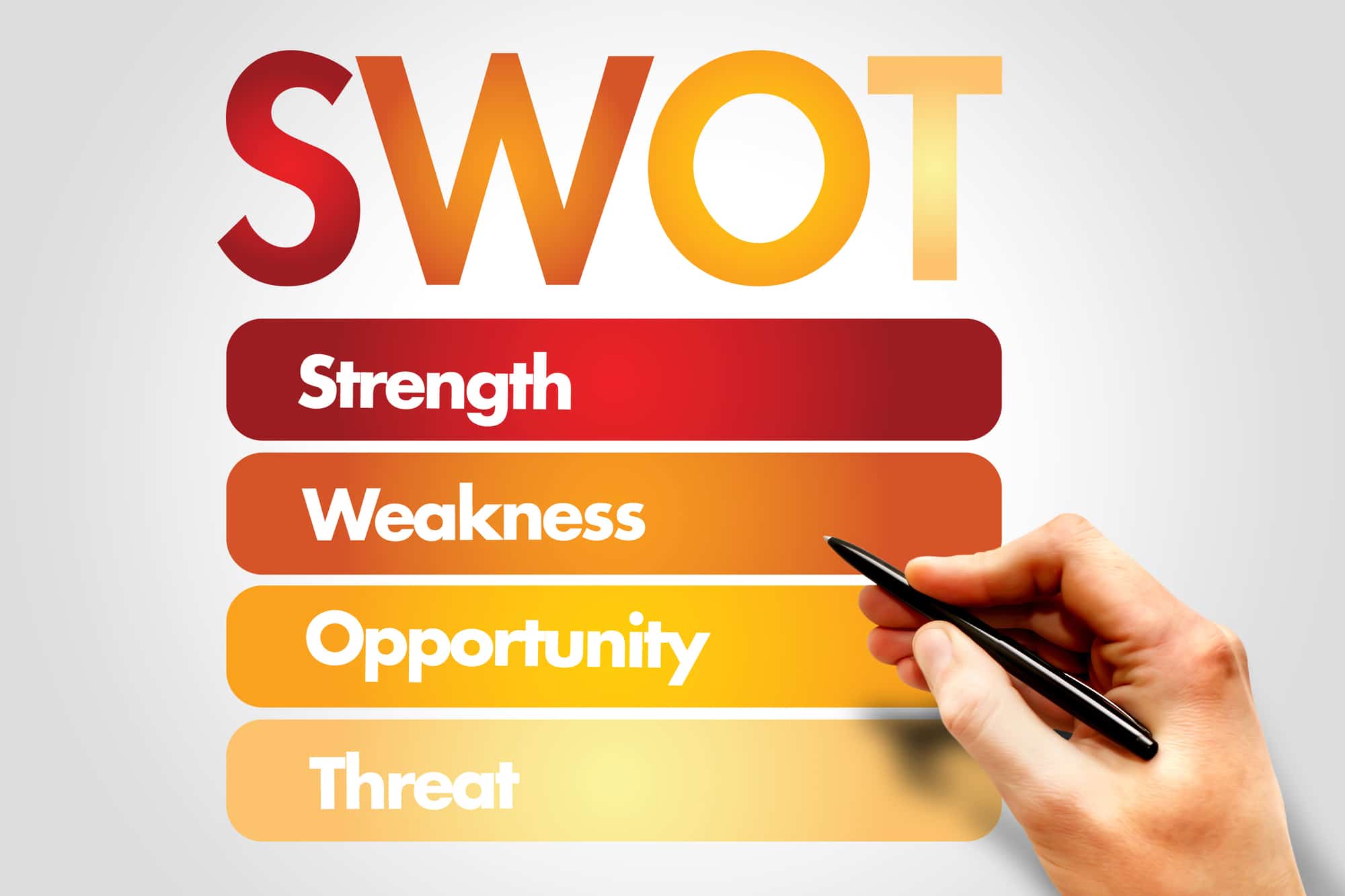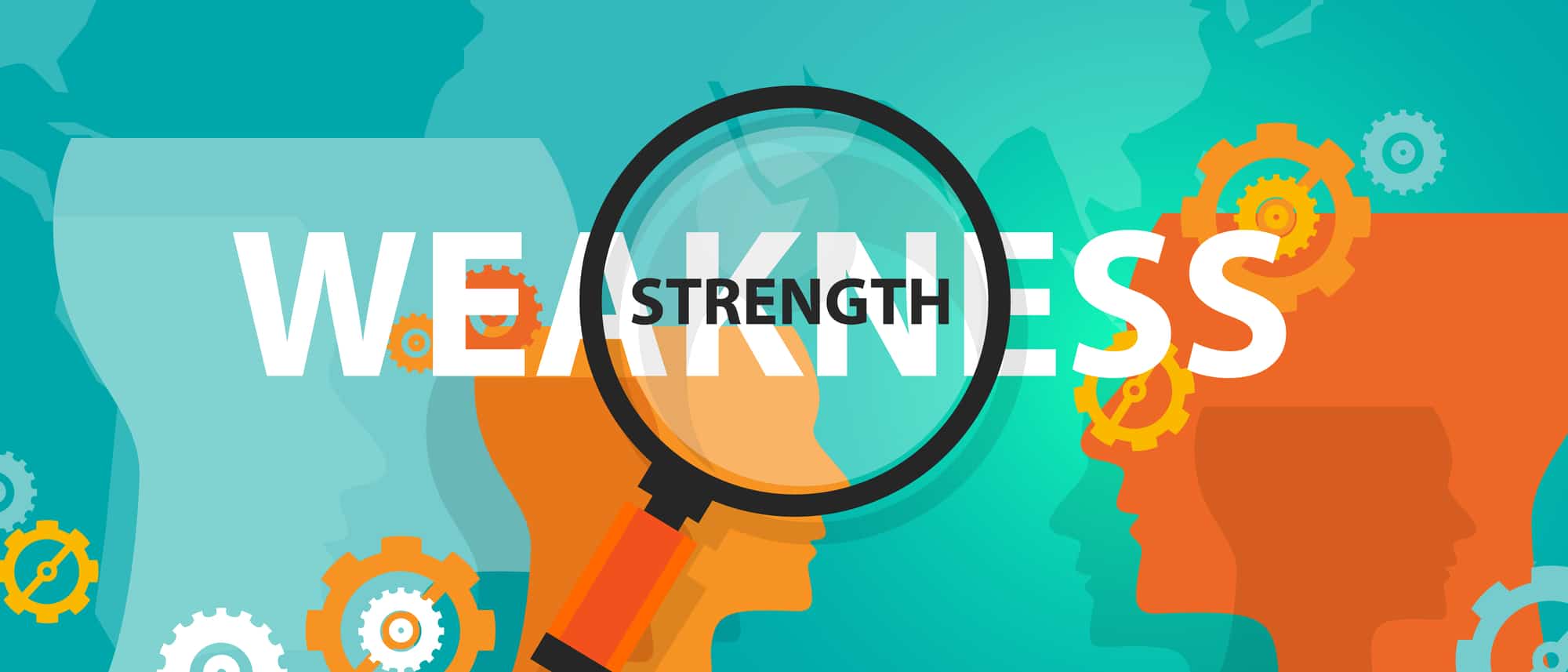Based on SWOT Analysis weakness examples, we investigate and discuss weaknesses found in key industries and specific companies.
Businesses possess different types of weaknesses. However, successful businesses are the ones who overcome their weaknesses to attain growth.
The idea of overcoming weaknesses sounds idealistic, but you will be amazed to learn that it is common for businesses to overcome their weaknesses.
First, businesses identify their weaknesses by conducting a SWOT analysis. After that, they form a strategy to overcome the identified weaknesses.
Today, we have decided to focus on the weakness section of the SWOT analysis, so in today's article, we will discuss the SWOT Analysis Weakness Examples in detail.
If you’re looking to analyze a business or product, SWOT analysis can be a straight-forward, but yet extremely effective tool. It takes into account only the most important factors (Strengths, Weaknesses, Opportunities, and Threats) but still provides a good outlook on the circumstances your organization or venture finds or might find itself in.
SWOT analyses are often praised for their simplicity -- you list the different variables on paper (or in a SWOT Matrix, i.e. a SWOT table), and can make some meaningful conclusions just by reviewing them. However, many individuals may run into uncertainty when trying to decide whether or not something fits into one of the categories, and if so, which?
In this series of articles, we’ll be focusing individually on each of the four categories, explaining their definitions and importance, and giving informative examples. Strengths in SWOT analysis have already been covered, which leaves weaknesses for this article before we discuss opportunities and threats.
W is for Weaknesses: Definition
Every organization or venture has its weaknesses -- things that they don’t do so well (or even do poorly), or things that aren’t so good about them/it. Weaknesses are particularly noteworthy if they prevent you from achieving your ‘mission’ (even if that’s just earning money), or make doing so more difficult. This might mean unnecessarily leaking finances, improperly targeting clients, or poorly executing a service, among other things.
In more robust terms, we say that weaknesses are negative and internal -- they cause harm (or prevent benefit) and are intrinsically related to how the organization is managed or the venture is realized.
The difference between weaknesses and threats is much like the difference between strengths and opportunities: that the latter is external. This means that every organization or venture competing in the same space faces the same threats, but the weaknesses are unique to how the entity is run/designed.
Weaknesses: Why include them?
If you know your weaknesses, you can work towards improving them. As mentioned previously, some weaknesses can prevent you from achieving your mission and goals, so if you can get rid of them, it’s certainly worth doing so.
A SWOT analysis highlights the internal and external factors that affect the operations of organizations. The internal factors affecting a business can be divided into strengths and weaknesses.
Since today's article focuses on weaknesses, let's discuss the internal weaknesses of an organization.

Internal Weaknesses
Internal weaknesses refer to the weaknesses that arise from within the organization. Let's take a look at different types of internal weaknesses.
Operational Inefficiencies
Operational inefficiencies are the inefficiencies that result from the internal operations of a business. These inefficiencies negatively impact the performance of an organization. Let's discuss what factors cause operational inefficiencies.
Outdated Technology And Systems
Using outdated technology can lead to inefficiencies. For example, outdated software may not have the computing ability required to compute the expenditures of a business, or outdated software may not provide accurate results.
Lack of Process Streamlining
Many business processes have redundant steps that are not required at all. These unnecessary processes increase the lead time and increase the inefficiency. Moreover, a lack of process streamlining prevents businesses from responding quickly to changes in demand.
Ineffective Workflow Management
A smooth workflow is necessary to increase productivity. However, many businesses have an ineffective workflow. This means there are challenges in coordinating tasks, and miscommunication is present, causing the productivity of a business to be compromised.
Human Resources
Human resources refer to the workforce that is present in any organization. There are many internal weaknesses associated with an organization's human resources. Let's look at how human resource adds to the internal weaknesses of an organization.
Skill Gaps And Training Needs
Skill gaps are the gaps between employees' skills and the skills required to carry out certain tasks. Skills gaps act as a weakness since they lower the productivity of an organization.
Moreover, training needs refer to the areas where employees lack skill and require further development. Training needs are also a weakness since the workforce will take time to learn new skills.
Low Employee Morale
Low morale refers to low motivation. If employees have low motivation, the productivity of the business is compromised. Employees can have low motivation for various reasons. Businesses need to solve the problem affecting the morale of employees to increase productivity.
Inadequate Leadership or Management
Lack of leadership skills in the management personnel makes a business less productive. Moreover, it results in poor decision-making, which affects the organization's performance.
Financial Weaknesses
Financial problems cause some of the weaknesses. This section will highlight the weaknesses arising from financial problems.
High Debt or Financial Obligations
High debt or finance obligations are considered a weakness of the organization. If a business pays a significant portion of its revenue in the repayment of loans and interest payments, then it would have little left to re-invest in the business.
Moreover, such businesses won't have enough money to spend on R&D or the latest technologies.
Poor Cash Flow Management
Poor cash flow management is an unhealthy balance between cash inflow and outflow. Cash flow problems cause delayed payments and increase the reliance on external payments.
Limited Budget Allocation For Growth Initiatives
A limited budget due to budget constraints hinders the growth of an organization since less money is spent on growth initiatives. Moreover, a limited budget prevents businesses from launching new products.

Product or Service Weaknesses
There are also weaknesses associated with the products and services that businesses offer. In this section, we will analyze the weaknesses caused by the products and services businesses offer.
Quality Issues
Businesses need to solve problems related to the quality of their products and services. Let's look at the weaknesses that arise due to the quality issues.
Product Defects or Flaws
Product defects are considered a major weakness of a business. It leads to customer dissatisfaction. As a result, the brand's image is damaged. Moreover, flaws in the products can also harm the customers. In this case, lawsuits can be filed against the business.
Service Delivery Problems
Issues related to the delivery of the service act as a weakness of a business. If the business fails to deliver services within a specific time, the brand's customer base will get damaged. Moreover, negative reviews from customers will affect the brand image negatively.
Lack of Innovation In Offering
The products or services provided by businesses may get outdated. When that happens, businesses have to launch new products or services; otherwise, this weakness can lead to a loss of market share. Moreover, a lack of innovation can push the business out of the market.
Market Positioning
Market positioning holds great significance since it helps businesses generate revenue. This section will analyze how market positioning can act as a company's weakness.
Weak Brand Image
A weak brand image means the targeted audience didn't perceive the brand well. This acts as a weakness of a business. Weak brand image may occur due to a lack of presence, negative associations with the brand, or lack of differentiation.
Ineffective Marketing Strategies
An ineffective marketing strategy limits the reach of the brand. This weakness arises from a weak marketing plan. Moreover, businesses make ineffective marketing strategies if they don't have enough resources to make effective marketing strategies.
Limited Market Reach or Penetration
Limited market reach is a weakness since many targeted audiences cannot reach the brand. Limited market penetration causes businesses' revenue to fall. This weakness can be overcome by increasing the market reach.
Examples of Weaknesses Impacting Businesses
Weaknesses are the shortcomings of businesses that prevent them from achieving their true potential. Let's take a look at how different weaknesses impact businesses.
Technology Companies
Technology companies are increasing in today's era of modernization. In this section, we will discuss how different weaknesses impact technology companies.
Software Bugs And Glitches
The glitches and software bugs in technology companies' systems are a weakness since they can affect the user experience. Software bugs can damage the sensitive data stored in technology companies.
Lack of Scalability In Products
If a product lacks scalability, the business won't be able to manufacture it to meet the increased demand. This weakness of the business can prevent it from capitalizing on market opportunities.
Slow Adoption of Emerging Technologies
Wherever a technology emerges, businesses need to adopt that technology to gain a competitive advantage. If businesses adopt emerging technologies slowly, all the other players in the industry will already adopt the emerging technologies and increase their market share.
Manufacturing Industry
Businesses in the manufacturing industry also have a lot of weaknesses. Let's analyze the type of weaknesses businesses in the manufacturing industry possess.
Production Inefficiencies
Manufacturing companies possess weaknesses in the form of production inefficiencies. These inefficiencies cause profits to fall, affecting the overall operations of a manufacturing business. Moreover, production inefficiencies lead to wastage of resources.
Supply Chain Vulnerabilities
Natural calamities and geo-political conditions cause disruption in the supply chain. These frequent disruptions act as a weakness of manufacturing businesses. The disruptions in the supply chain cause delays in production and damage the reputation of the business.
Quality Control Challange
Businesses have a separate quality assurance department that ensures the product's quality is good. Suppose the business cannot control the quality of its products. In that case, it will lose its market share and damage its reputation.
Service-Based Businesses
Service-based businesses are the businesses that provide services. For example, banks provide financial services to their customers. In this section, we will look at service-based businesses' different types of weaknesses.
Customer Service Issues
Many businesses that provide services to their customers lack satisfactory customer service. This weakness affects the customer base of the businesses. Moreover, customers give negative feedback about the business, which damages the reputation of the business.
Limited Service Offerings
Lack of diversity while providing services is a weakness of a service-based business. Customers prefer to take services from a business that offers various services. This weakness of providing limited services will cause the business's customer base to fall.
Difficulty In Retaining Clients
Some businesses struggle to retain their clients. This weakness of businesses leads the customer base of the business to shrink. As a result, the profits of the business fall.
More Examples of Weaknesses in SWOT Analysis
A few good examples should help to clarify what exactly constitutes a ‘weakness.’ Here are some both general and specific examples:
General Examples
- Unfriendly staff for a service-related business: if your clients interact with your workers a lot, it’s important that they get along. For a service-related business to have unfriendly staff would be a big weakness -- current and potential customers would be deterred, sales would drop, and so would profits.
- Over-complexity for a tech product aimed at less savvy users: if a product’s target market is less tech-savvy users, then they should at least be able to understand how to use it, if not how it works. Making the documentation and usage unnecessarily difficult would constitute a weakness, as the number of potential clients would decrease, as well as the number of satisfied clients.
Specific Examples
- High crash and bug rates for newer Windows operating systems: Starting from Windows Vista, Microsoft’s ‘Windows’ line of operating systems has gained internet notoriety for the high number of issues that occur, especially at release. This has led to some clients switching to more reliable alternatives, like Linux, or more straightforward alternatives, like Apple Macintosh operating systems.
- Unethical production for Nike: many of the world’s biggest apparel and footwear companies, including Nike, have been accused of exploiting workers in the Far East with low wages and poor ‘sweatshop’ working conditions.
- High price point for Starbucks: while this example is more subject to opinion, some might state that Starbucks’ high price point on almost all products deters a large portion of less well-off customers, and in turn loses them profit. However, others might argue that the high prices are definitive in their branding and necessary for good quality.

Strategies To Address Weaknesses
Businesses need to overcome their weaknesses, or else they won't survive in the market. Businesses adopt several strategies to address their weaknesses. In this section, we will look at some of the strategies to address weaknesses.
SWOT Analysis Integration Into Strategy Planning
The purpose of conducting a SWOT analysis is to identify the weaknesses that a business possesses. Once the weaknesses are highlighted, businesses can form a strategy to overcome the identified weaknesses.
Integrating the findings of the SWOT analysis into strategic planning will ensure that the weaknesses identified in the SWOT analysis are overcome. For example, if a business's SWOT analysis identifies its weakness, it is a lack of online presence.
The business must form a strategy to increase its online presence to overcome the weakness highlighted by the SWOT analysis.
Continuous Improvement Initiatives
Businesses need to take the initiative to improve their operations. For example, businesses must focus on increasing efficiency and effectiveness.
For example, suppose the SWOT analysis highlights that a business's slow response time in customer service is a weakness. In that case, the business must take the initiative to improve the response time in customer service.
Investment In Training And Development
Businesses must invest in training and development to overcome the weaknesses associated with an unskilled and less competent workforce.
For example, suppose a business's workforce doesn't have the skill to use a specific machine. In that case, the business can arrange workshops to upskill employees.
Restructuring And Process Optimisation
It is a process of reorganizing the organizational structure to mitigate the weaknesses associated with internal inefficiencies. Doing so aims to allocate the resources efficiently and enhance operational performance.
An example of restructuring and process optimization would be that, for example, if a product lacks scalability, this would be considered a weakness. This weakness can be overcome by restructuring and revisiting the product development process. Optimizing the product architecture might ensure scalability.
Innovation And Product Development
Businesses should focus on developing new products to mitigate weaknesses and capitalize on opportunities to gain a competitive edge in the market. Businesses that want to adapt to changing demands must adopt this strategy.
For example, if a business lacks R&D, it should invest in R&D and hire top intellectuals who can develop a new product. Once the business successfully develops a new product, it will have a competitive advantage, which will help it gain market share.

SWOT Analysis Weakness Example: Final Word
Bringing it all to a conclusion, weaknesses are negative, internal properties of all organizations and ventures. They warrant attention, as otherwise they can prevent the reaching of goals or realizing of missions. Examples of weaknesses are visible in every organization, even powerful, global ones across service and goods sectors.
SWOT analysis highlights the external and internal factors that impact the operations of a business. Today's article focused on the weaknesses section that the SWOT analysis highlights.
Every business possesses some weaknesses. However, these weaknesses can only be overcome after being identified. SWOT analysis helps businesses identify their weaknesses.
After that, businesses form strategies and make decisions to overcome those weaknesses. In this article, we discussed how businesses face internal and external weaknesses.
After that, we discussed how weaknesses impact businesses in various industries.
In the end, we shed light on the strategies that businesses adopt to mitigate their weaknesses.


